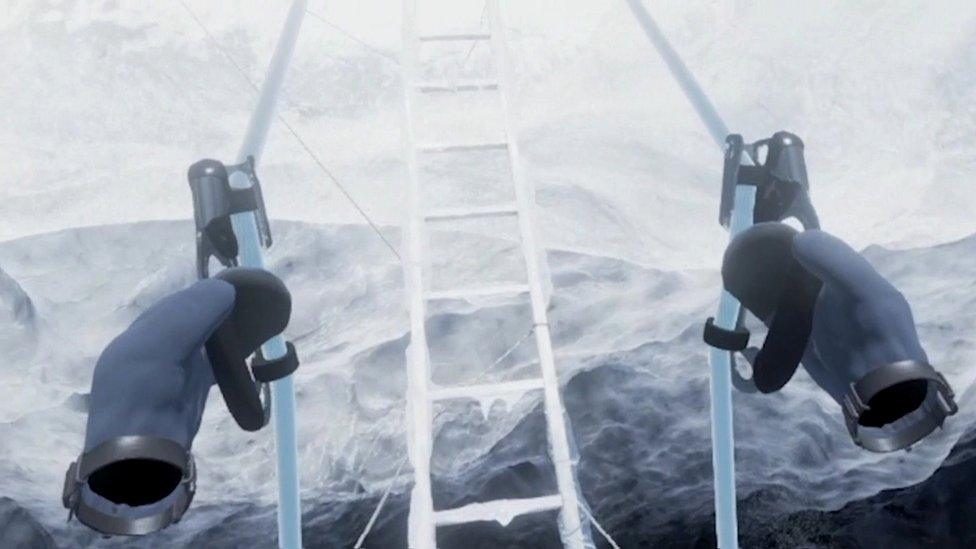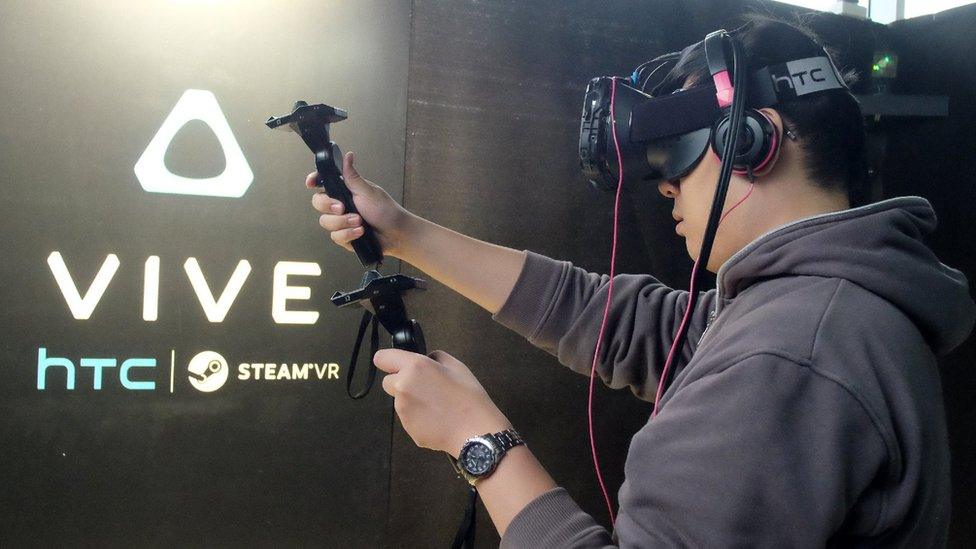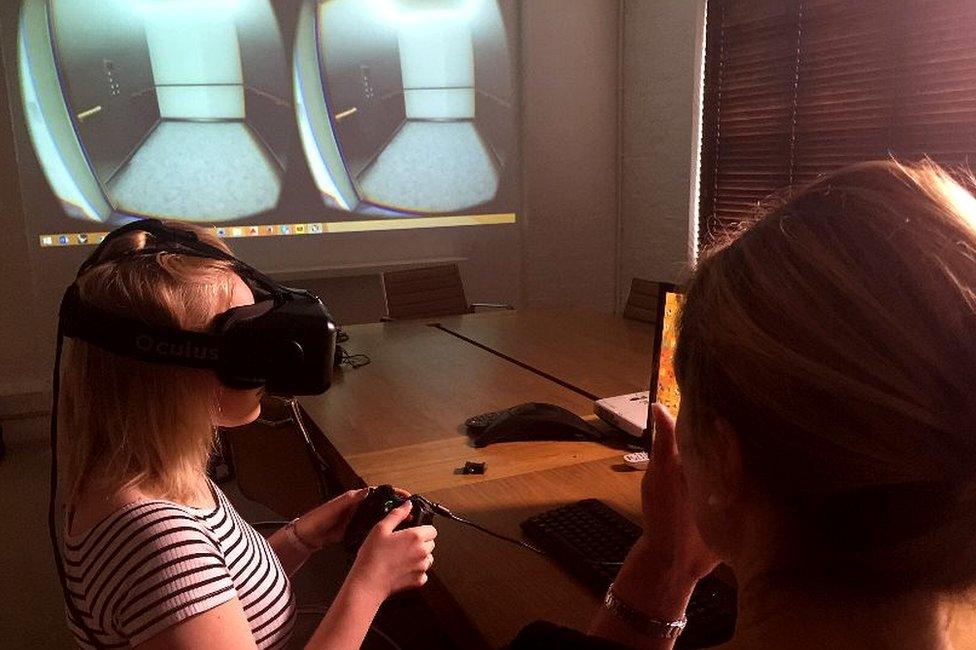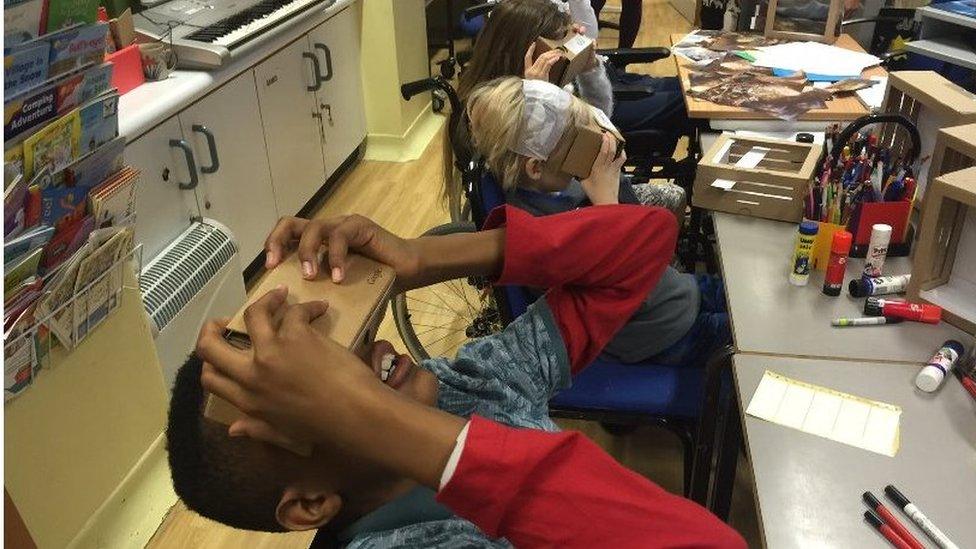2016: the year when VR goes from virtual to reality
- Published
- comments
Virtual reality is helping people face their phobias
Recently, I climbed Everest, making my way gingerly across a shaky bridge while trying not to look down into an icy chasm.
Then I watched as Helena, an 18-year-old with a fear of lifts, got into a series of them as a psychologist attempted to treat her phobia.
And finally, I saw a group of children take a tour of the Dulwich Picture Gallery without leaving King's College Hospital where they are long-term patients.

Everest VR uses hundreds of thousands of photos of the real mountain to create its views
In case you had not guessed, these were all examples of the use of virtual reality, which looks likely to be the big technology trend of 2016.
Given the amount of investment by players from Facebook to Sony to HTC, it will be a big disappointment if VR does not finally become, well, a reality in many homes this year.
My ascent of Everest, for example, came courtesy of the HTC Vive VR headset and a game developed by the Icelandic firm Solfar Studios.

HTC will reveal an update to its Vive headset at the CES tech show next week
The HTC Vive, seen by many as providing the best VR experience, was due to launch late last year but its debut was delayed for some further tweaking.
Now, it should join Sony's PlayStation VR and Facebook's Oculus Rift headset on the market in the next few months.
The games industry is betting big on virtual reality, but there may be questions about the breadth of content available to players at first.
Games like Everest provide a great immersive experience.
But turning virtual reality from a "wow that's amazing" moment into a game that provides months of entertainment won't be easy.
Whether many hardcore gamers will rush to invest in the technology remains to be seen.
I suspect that, just as Microsoft found with its Kinect motion sensor, many gamers will see VR as no more than a gimmick.

Space war game Eve: Valkyrie will be released on both Oculus and Sony's VR systems
But just as Kinect's technology has found lots of uses beyond games, virtual reality may still prove a ground-breaking technology in many areas of life.
Two London psychologists, Dr Ashley Conway and Dr Vanessa Ruspoli, certainly believe that is the case. They have developed a system that uses Oculus' Rift headset to treat patients with phobias.
Their company Virtual Exposure Therapy aims to give patients exposure in a virtual world to the thing they fear.
We filmed Helena, who's always been scared of getting into lifts, being guided into a series of smaller and smaller spaces.
Dr Ruspoli kept on checking her anxiety levels as she entered each lift, and after a while the anxieties dropped.

Helena was able to travel in a real lift after practising in virtual reality
"It's not the real world but a very visceral experience," Dr Conway explained.
"You get a physiological reaction. It's a really good bridge between not being able to do something and doing it in the real world."
The psychologists hope to use the system to treat a range of phobias, from fear of flying to agoraphobia, where semi-realistic exposure to the feared environment might help.
After her treatment, we persuaded Helena to get into a noisy old-fashioned lift.
She told me VR had made a difference - she'd have opted to take the stairs just a few weeks earlier.
Many businesses and public bodies may soon use VR as a way of interacting with consumers - estate agents will be able to give virtual tours of properties, kitchen designers will be able to give customers a better idea of what they are buying.
Hospital patients visit the Dulwich Picture Gallery via VR
Cheaper and simpler systems like Google's Cardboard VR headset, where you slot in a smartphone, may provide most people with their first virtual reality experience.
Among the organisations now trying to use the Google headset as a way to deliver VR is the Dulwich Picture Gallery.
It made quite a simple virtual tour of the gallery and tried it out on some young patients at nearby King's College Hospital.
Their reactions were a delight.
"You do get the feel of being there and seeing the paintings, it's really cool", said Lucy.
"You can definitely see it's fake," added Maya, "but for a little person they probably think it's the most amazing thing in the world."

Google Cardboard offers an alternative to more expensive systems
But Edward pointed out: "It's not as good as the actual thing, it's not like a real museum."
Virtual reality will bring new ways for all sorts of organisations and businesses to talk to us.
This year we may find out whether, in Edward's words, it's as good as the actual thing.
Read more about the new virtual reality systems in our CES preview, which will be published on 2 January.